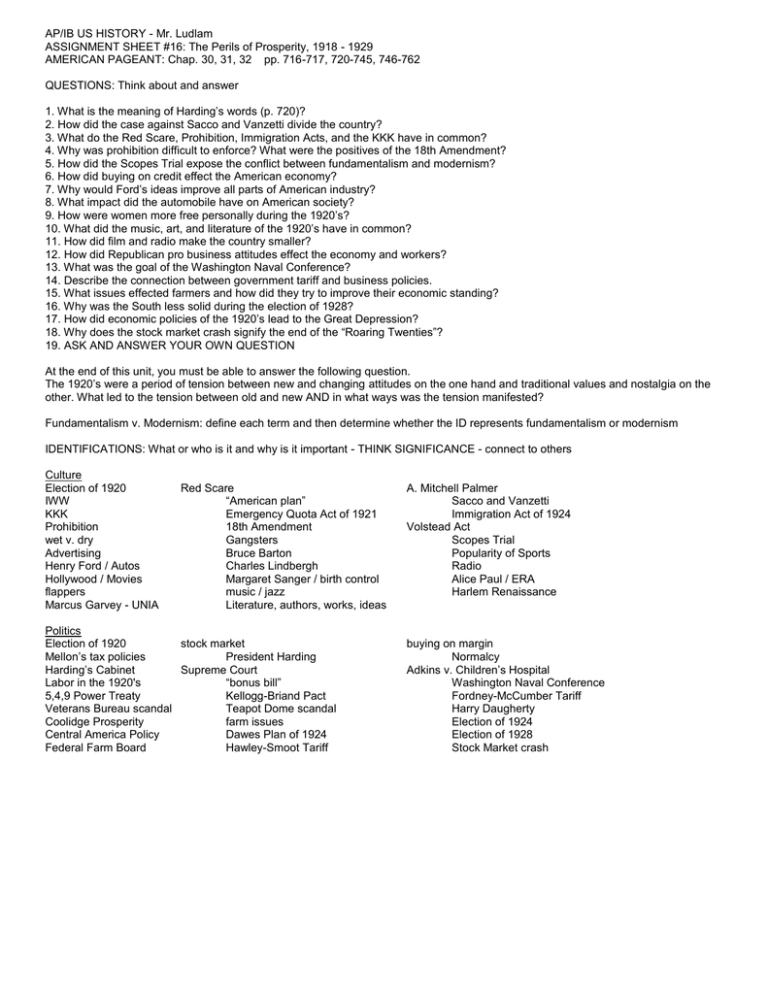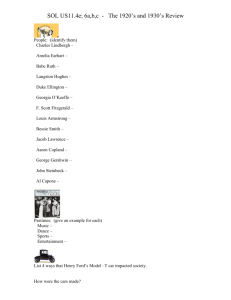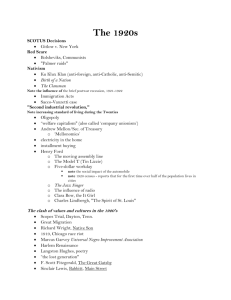AP/IB US HISTORY
advertisement

AP/IB US HISTORY - Mr. Ludlam ASSIGNMENT SHEET #16: The Perils of Prosperity, 1918 - 1929 AMERICAN PAGEANT: Chap. 30, 31, 32 pp. 716-717, 720-745, 746-762 QUESTIONS: Think about and answer 1. What is the meaning of Harding’s words (p. 720)? 2. How did the case against Sacco and Vanzetti divide the country? 3. What do the Red Scare, Prohibition, Immigration Acts, and the KKK have in common? 4. Why was prohibition difficult to enforce? What were the positives of the 18th Amendment? 5. How did the Scopes Trial expose the conflict between fundamentalism and modernism? 6. How did buying on credit effect the American economy? 7. Why would Ford’s ideas improve all parts of American industry? 8. What impact did the automobile have on American society? 9. How were women more free personally during the 1920’s? 10. What did the music, art, and literature of the 1920’s have in common? 11. How did film and radio make the country smaller? 12. How did Republican pro business attitudes effect the economy and workers? 13. What was the goal of the Washington Naval Conference? 14. Describe the connection between government tariff and business policies. 15. What issues effected farmers and how did they try to improve their economic standing? 16. Why was the South less solid during the election of 1928? 17. How did economic policies of the 1920’s lead to the Great Depression? 18. Why does the stock market crash signify the end of the “Roaring Twenties”? 19. ASK AND ANSWER YOUR OWN QUESTION At the end of this unit, you must be able to answer the following question. The 1920’s were a period of tension between new and changing attitudes on the one hand and traditional values and nostalgia on the other. What led to the tension between old and new AND in what ways was the tension manifested? Fundamentalism v. Modernism: define each term and then determine whether the ID represents fundamentalism or modernism IDENTIFICATIONS: What or who is it and why is it important - THINK SIGNIFICANCE - connect to others Culture Election of 1920 IWW KKK Prohibition wet v. dry Advertising Henry Ford / Autos Hollywood / Movies flappers Marcus Garvey - UNIA Red Scare “American plan” Emergency Quota Act of 1921 18th Amendment Gangsters Bruce Barton Charles Lindbergh Margaret Sanger / birth control music / jazz Literature, authors, works, ideas Politics Election of 1920 stock market Mellon’s tax policies President Harding Harding’s Cabinet Supreme Court Labor in the 1920's “bonus bill” 5,4,9 Power Treaty Kellogg-Briand Pact Veterans Bureau scandal Teapot Dome scandal Coolidge Prosperity farm issues Central America Policy Dawes Plan of 1924 Federal Farm Board Hawley-Smoot Tariff A. Mitchell Palmer Sacco and Vanzetti Immigration Act of 1924 Volstead Act Scopes Trial Popularity of Sports Radio Alice Paul / ERA Harlem Renaissance buying on margin Normalcy Adkins v. Children’s Hospital Washington Naval Conference Fordney-McCumber Tariff Harry Daugherty Election of 1924 Election of 1928 Stock Market crash







